
For a full two decades, there were no new visual media installments in the Blade Runner franchise. Following the well-received 1997 point-and-click computer game for Microsoft Windows, there were only some novels and comic books set in the universe established by the seminal 1982 film, but nothing new for the screen until 2017 – which saw the release of the feature-length sequel to the original film in Blade Runner 2049, as well as three short films – one of which was anime.
But in November 2021, the next visual installment of the franchise hit small screens everywhere with “Blade Runner: Black Lotus,” an anime television series. The series follows a woman in Los Angeles in 2032 who seeks revenge on those that have wronged her while also trying to uncover the mystery of her past, with only a locked data device and a tattoo of a black lotus as clues to guide her.
Streaming on Crunchyroll and Adult Swim (Toonami), the CGI-animated series is an original co-production by the two companies in partnership with Alcon Entertainment, with animation handled by Japan studio Sola Digital Arts.
Sola has worked on the anime series Ghost in the Shell: SAC_2045 and Ultraman (2019 version), as well as several Starship Troopers animated features and the anime movie Appleseed Alpha.
When Black Lotus was first announced in November 2018, many assumed the series would resemble the 2017 short film “Blade Runner Black Out 2022” – a prequel to “Blade Runner 2049.” Directed by “Cowboy Bebop” and “Samurai Champloo” helmer Shinichirō Watanabe, the 13-minute film was presented in a mostly hand-drawn aesthetic with only some CG mixed in.
But the new series – which is slated for 13-episodes its first season – is presented entirely in CG – even the opening title sequence, which was directed by Johnny Likens of Method Studios.
Watanabe serves as a creative producer on the new series, but directorial duties are being handled by Shinji Aramaki and Kenji Kamiyama. Aramaki directed several CG film entries in the Appleseed and Starship Troopers franchises. Kamiyama directed several entries in the Ghost in the Shell: Stand Alone Complex franchise. The pair co-directed together twice before Black Lotus, on the anime series “Ghost in the Shell: SAC_2045” and “Ultraman” (2019). Kamiyama is also the creator and director of the anime series “Eden of the East” and anime feature “Napping Princess,” and directed the anime series “Moribito: Guardian of the Spirit.” Aramaki was also the creator and director of the 1987 cult hit original video animation “Metal Skin Panic MADOX-01” which rode the anime home video boom of the 1980s to popularity.
So, between the two of them, the pair bring quite a pedigree to the first ever Blade Runner television series.

In some ways, a Blade Runner anime brings the franchise full-circle, Black Lotus executive producer Joseph Chou said.
“Blade Runner has a different weight to it because of its legacy and impact on anime in general,” he said. “Blade Runner presented a future where it was very gritty and real world, dystopian, dark, noir, all of these things. That vision impacted this whole genre of anime called cyberpunk that people love. Look at a title like Akira or Ghost in the Shell, which made a huge mark and a lot of the sci-fi anime that came after that – Cowboy Bebop or any title you can think of that take place in the future and where did that come from? Blade Runner.”
Chou got his start producing anime by getting involved the in the development of “The Animatrix,” which was an anime anthology film set in the world of The Matrix films.
Because of the how successful that had been at adapting a live action property into anime (it went on to become one of the top-selling anime DVDs in the North American market) – he was put in charge of a division within Warner Bros Home Entertainment group to oversee new Japanese anime projects that crosspollinated with Warner franchises.
Chou thought about what property to transform into anime next, and Blade Runner was at the top of his mind. He pursued the project for 15 years while his division went on to make the anime anthology films “Batman: Gotham Knight” and “Halo: Legends.”
And it was the “phenomenal reaction” to the short film “Blade Runner Blackout 2022” that showed there was potential for more animated installments of the franchise, Chou said.
“It’s an opportunity that’s not given so easily so even though I’ve been after it for 15 years, I don’t take it for granted, I think it’s a miracle that it happened,” he said. “So I hope that we all deliver at the end of the day for the fans of the franchise and for the newcomers to the franchise. I still can’t believe that I’m doing it.”
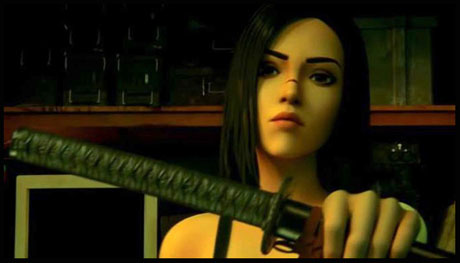
Honoring An Inspiration
For the two co-directors of Black Lotus, the original film – which turns 40 this year – played an important part informing their careers. But being fans themselves only added to the pressure to be allowed to create one of the rare new installments in the decades-old franchise.
“The Blade Runner series had an incredible impact on me, especially visually,” Aramaki said. “I came to like it more and more each time I watched it. That’s the kind of film it was. It was a very important work that left a strong impression on me. We want to make sure we get it right and everybody I think has that sense of duty by being part of this universe and being allowed to play in this universe.”
There are a lot of Japanese language signs in the original film, which while Chou said they aren’t necessarily correct Japanese letters or words, they made the film more endearing to Japanese people.
“I have works that I have made that incorporate things inspired by Blade Runner,” Kamiyama said. “But being able to touch the original was a difficult task. Fans from all over the world would be paying attention, so more than happiness, there was some pressure that came with our creating a new work in that series. Because there is such a strong attachment to the Blade Runner work, and because it was such a perfectly crafted world, finding how to make that into a new work was the hardest thing.”
But at the same time, their work is going to look different and going to feel different, the directors said, and Black Lotus “has to kind of live on its own,” they said.
As they went with a fully-CG animation production with some motion capture by human actors, it was important to them to decide what CG animation can do that hand-drawn animation can’t do, they said.
Primarily that was in how the camera gets handled and how the action gets portrayed, they said.
It was possible through CGI to actually approach the camera in the series like a live action film, they said. They tried to be conscious of not making dramatic stylistic camera choices that a typical anime would do, but rather something more grounded in reality.
Another thing that was very important for them to pay attention to was the lighting, particularly in backgrounds, calling the lighting a “character unto itself.”
“Visually speaking we needed to get that right,” they said.
When Blade Runner first came out, it was a “huge shock” visually for audiences, Chou said. From the neon signs to dark alleys and rain-soaked streets, it wasn’t the squeaky-clean sci fi that people were used to back then, he said.
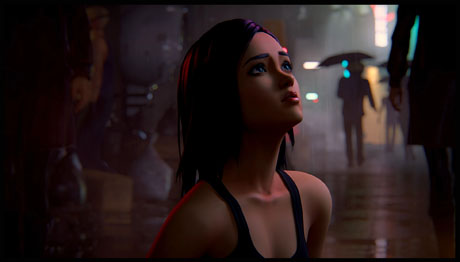
The animators sought to capture the level of detail and the design of the world seen in the two feature films.
“The city itself, the environment itself, the look of it also is a major character,” Chou said. “This future is not gleaming, white, shiny buildings. It’s a dirty, grungy world where it rains a lot. You could say that’s one of the characters in Blade Runner and they had to do it right.”
And the animators were aware that when comes to CG, there’s a spectrum from cartoony to photorealistic, Chou said. But they decided neither one was a good choice and they had to fall somewhere in the middle.
“The goal was a look that that’s evocative and that’s unique for the show, but at the same time, it had to be familiar enough so that viewers would once look at it and say ‘yes, that’s Blade Runner,’” he said. “That was something that was pretty difficult thing to do, so there was a lot of visual development process that went on, and to arrive at the right aesthetic was a huge challenge.”
Expanding the world
When considering the setting and characters, the trio figured that there was another world that extended beyond the camera lens of the two feature films, a place that the protagonists of Deckard (from the 1982 film) and K (2017 film) weren’t a part of.
“So I wondered what it would be like if we took the approach of exploring what I suppose you could call the replicant world, or the time in which they lived,” Kamiyama said. “I really liked the original, so if I had let myself get too engrossed in that, I may have had a world view that trivialized it. So I tried as best as I could to find a world that wasn’t depicted in the original two movies. That is the approach we took.”
It was important to not just decide that the show would be animated and then adapt Blade Runner around that, it was important to capture the essence of Blade Runner in animation, Chou said.
And in order to do that, they really needed to understand what Blade Runner is at its core, he said, and needed to deliver that to the audience as well, so that long-time fans would accept this new series as a part of the Blade Runner world.
“Something that the directors had to also constantly think about when trying to bring new elements into this longform story – when it came to the look or the action or anything that they did – they constantly had to think about, ‘okay, well, will this be accepted by the Blade Runner fans? Will this be accepted as something that’s going to be called Blade Runner-esque that fits in the canon?’ You know, it’s something that they really had to struggle with – the whole balance of it,” Chou said.
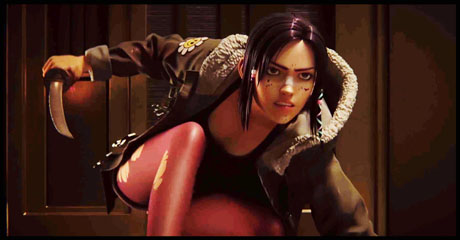
Topical themes
The first Blade Runner film was a “revolutionary movie,” Chou said. More than just neon signs and rain-soaked streets, the replicants can be seen as representing racial issues. And there are issues with corporations taking over society and impacting the lives of the people living in it, and creating environmental problems.
“There are a lot of relevant issues that that we could cover in this property,” Chou said. “One thing that is most poignant is about the Wallace Corporation – a giant corporation sort of taking control of society with the use of technology. With Wallace’s attempt to control the replicant technology and trying to control labor and the means of means of economic productions, that brings into question what is the worth of human life? What is the meaning of human life? It’s not something that we wanted to tackle directly. It just came out naturally because of how the story is set up rather than being intentional. As it’s basically the theme of the story itself, it just basically kind of seeps out as you are tackling this series.”
Also, by featuring the franchises’ first female protagonist, Elle’s struggles and the challenges she overcomes can be understood as a gender issue and a discrimination issue, Chou added.
Telling a longer story
As this is a longform series, it is a different format from the two movies it’s based on, with a story told over many episodes, making it a different type of storytelling, Chou said. As such, while the films were about the protagonists’ personal journeys and paths of personal discovery, the entire series cannot be all about Elle’s journey because they’ll run out of storylines and it’ll be hard for viewers to focus on.
They needed to bring some other factor into the show to make it bigger than one character, Chou said, so they decided to tell the story of the replicants and what the structure of their conflict is, which was touched upon in the films – corporations against individuals.
“You have to really think about how to bring that into to the center so that there’s something more that will intrigue people and have people really want to be invested in the storytelling itself of the series,” he said. “So that’s something that you really try to strike a balance of. You have to deliver something that’s entertaining, that’ll have people keep people coming, delivering the suspense and delivering a visceral feel to it so that people want to stay with us throughout the series.”
And besides for delivering entertainment, Chou hopes the audiences’ emotional investment in Elle will deliver some kind of catharsis.
“You have Elle, a unique replicant who is the hero getting revenge,” Aramaki said. “That’s what it comes across as – but at the same time – it’s a story of self-discovery. As the story unfolds, there are various mysteries in this world, that gradually get solved. And I think it will be interesting both for people who watch [this world] for the first time and for those of us who have a strong understanding of the world of Blade Runner. I hope that [both] can enjoy that.”
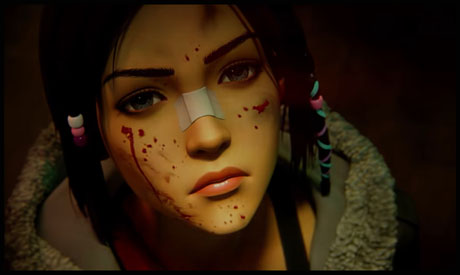
Inviting in newcomers
Chou said that another factor that they considered while creating the series was besides for it being “a wonderful universe to play in,” they had to decide what the point was for making the series in the first place.
One reason Chou was excited to offer the latest Blade Runner story in animation rather than live-action is he saw it as an opportunity to try and expand the franchise to a new audience, he said.
It being done as a CGI animation got them thinking about not only trying to expand the Blade Runner world while being faithful to longtime audiences by delivering its essence, but that its utility as an animated work is possibly serving as an entry point to franchise newcomers, being as the original film is nearly 40 years old.
As such, for viewers who potentially have not seen the live action films, the directors thought about the action, drama and entertainment provided by the show through the lens of it being an entry point and considering what was new that they could contribute to the franchise.
“And I guess the result is the work that we have,” Chou said.
Fast Five Q+A:
Animation Scoop asked the directors a couple of questions about the series and here’s what they had to say:
Q: The Blade Runner 2022 anime short film by Shinichiro Watanabe was done in a hand-drawn/cel-animation style. When “Black Lotus” was announced, some fans anticipated the series would have a similar design or aesthetic. What made you decide to go with a pure CG style for this series? Was a more traditional animation style, or even a cel-shaded CG style (which is increasingly popular for anime series) ever considered or was CG always the vision?
Aramaki: Director Watanabe had his own personal vision of the style he wanted to express through “Black Out 2022”. In the same way, we had our own vision and style that we wanted to express in this film, which is why we took the approach we did.
Kamiyama: Because “Black Out 2022” was a short film, Director Watanabe was able to produce the animation in the way he did. These days in Japan, it’s been pretty difficult to complete a whole TV series in that style. SOLA Digital Arts is a 3DCG animation studio, so we thought it was best to use this format as it’s what the studio is known for and is very good at doing.
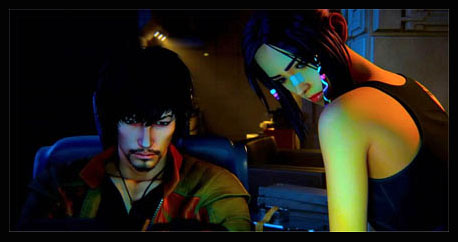
Q: The first time the Blade Runner franchise appeared in CG animation was the 1997 video game. The game was critically well-received and has become a cult classic for some of the fans of the franchise. Was the aesthetic of that game at all considered when doing visual/concept art for this series?
Aramaki: I wasn’t aware of the video game that you’ve mentioned, so that was not put into consideration for this series. We had only referenced the original “Blade Runner” film and “Blade Runner 2049”.
Kamiyama: I didn’t think much about that. My focus was really on how to recreate the atmosphere of the original film
Q: Which characters from the two feature movies, or the three short films will appear in this animated series?
Aramaki: Niander Wallace and Doc Badger. They both are in the first episode.
Kamiyama: There’s two character’s you’ll see from “Blade Runner 2049”, Niander Wallace Jr. and Doc Badger.
Q: In many ways the Vangelis score from the original Blade Runner film is equally iconic as its story and visuals. Does your score for the series draw from Vangelis, or does it draw from the 2049 score by Hans Zimmer and Benjamin Wallfisch, or is it entirely its own music without drawing from/quoting the previous scores?
Aramaki: When we were discussing the music, I stressed the fact that the soundtrack should be respectful to the music of the original movie, but I also didn’t think it needed to be exactly the same. I wanted the music to be new but emotional, just like when I first heard Vangelis’ music in “Blade Runner”.
Kamiyama: My concept was that I wanted the music to be mindful of the flow of the two films. But I think the (musical) artists also wanted to be able to try something new. In the end, I think it went in the right direction, the music has its own originality blended together with the traditional Blade Runner style music we know and love.
Q: Was any of the ‘expanded universe’ media of Blade Runner referenced, consulted or used for worldbuilding or plotting — the novels, comic books, or video games?
Aramaki: No, it was really the two movies that were the base of creating the world view of this series.
Kamiyama: As Aramaki-san said, none of the above you mentioned were really used at all. The two films were the basis of everything.
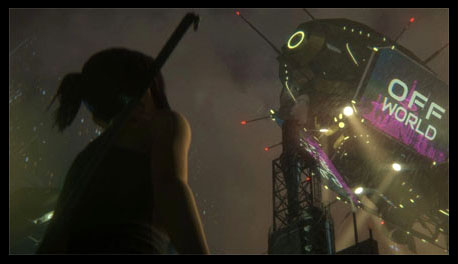
Editor’s note: The quotes in this feature come from a the “Benefit or Hazard” documentary released on Nov. 7 in conjunction with the series, as well as a press roundtable held on Nov. 9th. New episodes premiere on Sundays on Adult Swim and Crunchyoll.
- Going-In-Depth: Adult Swim’s “Smiling Friends” - March 8, 2022
- Diving Into Adult Swim’s “Blade Runner” - March 5, 2022
- “Teenage Euthanasia” premieres on Adult Swim Sept. 19 - September 25, 2021


 March 5th, 2022
March 5th, 2022  Neal Patten
Neal Patten  Posted in
Posted in  Tags:
Tags: 






